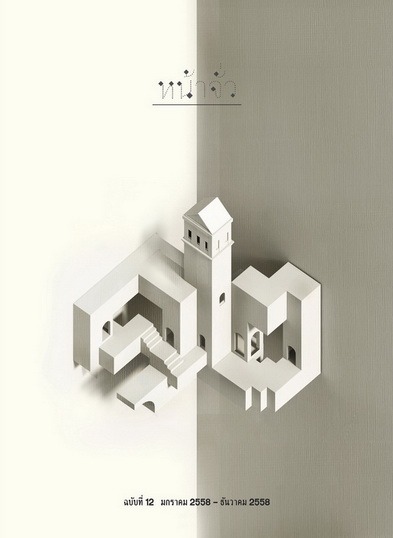เลอ คอร์บูซิเอร์ และการวางผังเมือง “แพลนโอบุส” สำหรับเมืองอัลเจียส์/ Layering Modernity : Le Corbusier and his ‘Plan Obus’ planning on Algiers
Main Article Content
Abstract
บทคัดย่อ
“สถาปนิกและนักประวัติศาสตร์ได้จำแนกผลงานในช่วงชีวิตของเลอ คอร์บูซิเอร์ ออกเป็น 2 ช่วงหลัก นั่นคือยุคปีเริ่มต้น จากการออกแบบ Maison Dom-ino (ค.ศ. 1913) ไปจนถึง Villa Savoye (ค.ศ. 1929) และในยุคหลัง เริ่มตั้งแต่อาคารชุด Marseilles block (ค.ศ. 1946) ขยับขยายจนไปถึงการออกแบบผังเมืองและวางผังอาคารต่างๆ สำหรับเมืองหลวงอย่าง Chandigarh (ค.ศ. 1952-1965)” การจัดแบ่งช่วงการทำงานของเลอ คอร์บูซิเอร์ ออกเป็น 2 ยุคนี้ถูกกล่าวถึงโดยศาสตราจารย์ Mary McLeod ตีพิมพ์ลงในบทความเรื่อง Le Corbusier and Algiers ในวารสาร Oppositions เมื่อ ค.ศ. 1980 คำแถลงการณ์ด้านสถาปัตยกรรมของเลอ คอร์บูซิเอร์ ในยุคแรกนั้นแสดงออกถึงความชื่นชมในการออกแบบด้วยระบบเครื่องจักรและโรงงานอุตสาหกรรมเพื่อตอบสนองการขาดแคลนด้านที่อยู่อาศัยของเมืองช่วงยุคหลังสงคราม จึงเป็นเหตุผลที่ทำให้งานออกแบบของเลอ คอร์บูซิเอร์ มีเอกลักษณ์เฉพาะตัว ในยุคเริ่มต้นอาคารของเลอ คอร์บูซิเอร์ ถูกจำกัดอยู่บนพื้นฐานของความเป็นเหตุเป็นผล ฟังก์ชั่นถูกออกแบบให้สอดคล้องกับการใช้งาน ตั้งอยู่บนพื้นฐานของระบบพิกัดคาร์ทีเซียน (Cartesian) และมีหลักการมากพอสมควร หากแต่ในช่วงยุคหลังการออกแบบของเขาได้ถูกปรับเปลี่ยนไปในทิศทางตรงกันข้าม ผลงานต่างๆ ได้ถูกอธิบายเพิ่มเติมด้วยอารมณ์ความรู้สึก มีความเป็นกวี ลื่นไหล และมีการลงรายละเอียดด้านวัตถุมากยิ่งขึ้น การเปลี่ยนแปลงที่เห็นได้ชัดนี้เองได้สร้างขนบรูปแบบใหม่ๆ เพิ่มเติมให้แก่ Modern Movement ซึ่งถูกกล่าวถึงในการประชุม CIAM ครั้งที่ 4 ภายใต้หัวข้อ Athens Charter ใน ค.ศ. 1933 Siegfried Giedion ได้กล่าวถึงพัฒนาการของการศึกษาการออกแบบผังเมืองว่า “ได้พัฒนาจากการออกแบบโดยคำนึงถึงเพียงแต่ฟังก์ชันและประโยชน์การใช้สอยของสถาปัตยกรรมเพียง อย่างเดียวไปเป็นการรวมเอาองค์ประกอบอื่นๆ เข้าร่วมด้วย เช่น สุนทรียภาพ บริบททางสังคม และชีววิทยา” เขายังได้กล่าวอีกว่า “การพัฒนาไปถึงขั้นสูงสุดของสถาปัตยกรรมโมเดิร์นในครั้งนี้เป็นไปได้เนื่องจากการสร้างความสัมพันธ์เชื่อมต่อกับสถาปัตยกรรมในอดีตและมรดกวัฒนธรรมโบราณ (Hellenic heritage)” การค้นพบในครั้งนี้สร้างความเปลี่ยนแปลงครั้งใหญ่แก่เหล่าสถาปนิกและนักออกแบบผังเมืองของศตวรรษที่ 20 เนื่องด้วยเป็นการสร้างมุมมองที่ต่อต้านคตินิยมสรรผสาน (eclecticism) ความฟุ่มเฟือยในการออกแบบตกแต่งของสถาปัตยกรรมในยุคก่อนหน้า ดังนั้นการศึกษาผลงานต่างๆ ของเลอ คอร์บูซิเอร์ ในช่วงยุคหลังจะสามารถแสดงให้เห็นถึงแรงผลักดันที่ส่งผลต่องานการออกแบบของเขาให้เปลี่ยนแปลงไปจากยุคแรก นั่นคือ จากการออกแบบซึ่งมีลักษณะเป็นเส้นตรงไปสู่การออกแบบที่มีลักษณะเป็นเส้นโค้งมากขึ้นในช่วงรอยต่อระหว่าง 2 ยุคนี้ ได้แก่ ระหว่าง ค.ศ. 1929 จนถึง 1945 เป็นช่วงที่เลอ คอร์บูซิเอร์ ได้รับความผิดหวัง เนื่องจากถูกปฏิเสธผลงาน Plan Voisin ที่เขาเสนอต่อรัฐบาลฝรั่งเศส เขาได้เสนอให้ออกแบบและแบ่งส่วนพื้นที่เมืองปารีสใหม่ตามฟังก์ชั่นที่แท้จริงของเมือง ในช่วงเวลาดังกล่าวเลอ คอร์บูซิเอร์ ได้ศึกษาแนวทางการออกแบบผังเมืองอย่างหนักและมองหาพื้นที่แห่งใหม่เพื่อที่เขาจะสามารถทดสอบความรู้ความสามารถของสถาปัตยกรรมแบบโมเดิร์นได้อย่างเต็มที่ เป็นช่วงเวลาเดียวกันกับที่เขาเข้าร่วมขบวนการสหการนิยม (Syndicalism) และเดินทางไปเยือนสหภาพโซเวียต ประเทศแถบอเมริกาใต้และแอฟริกา ซึ่งทำให้เขาได้เข้าใจแนวความคิดของสถาปัตยกรรมพื้นถิ่นได้เป็นอย่างดีและลึกซึ้งยิ่งขึ้น การเรียนรู้เรื่องใหม่ๆ อย่างเรื่องวัสดุธรรมชาติและชีววิทยานี่เองทำให้เขาสามารถเพิ่มเติมฐาน ความรู้เข้าไปในทฤษฎีโมเดิร์น การค้นพบนี้ช่วยให้เขาเปลี่ยนความคิดจากในยุคเริ่มต้นที่ว่า “สถาปัตยกรรมโมเดิร์นเพียงอย่างเดียวมีความสามารถมากพอที่จะเปลี่ยนแปลงสังคมได้” พื้นฐานความรู้ใหม่ที่เลอ คอร์บูซิเอร์ ค้นพบในช่วงนี้ได้ถูกกล่าวถึงในบทความที่เขาเขียนและตีพิมพ์ลงใน La Ville Contemporaine (ค.ศ. 1922) และ La Ville Radieuse (ค.ศ. 1933) ในรูปแบบของข้อเสนอเรื่องการวางผังเมืองสำหรับเมือง Buenos Aires, Rio de Janeiro, Sao Paulo และอย่างยิ่งในการวางผังเมือง Algiers ซึ่งต่อมา ได้พัฒนาแนวความคิดนี้มาใช้กับการวางผังเมือง Chandigarh ใน ค.ศ. 1946 ถึง 1965
ดังนั้นการศึกษาวิจัยในครั้งนี้จึงมีความตั้งใจที่จะศึกษาความสัมพันธ์ระหว่าง Plan Obus ผลงานด้านการวางผังเมืองของเลอ คอร์บูซิเอร์ ซึ่งถูกสร้างขึ้นเป็นรูปธรรมสำหรับเมืองแอลเจียร์ เมืองหลวงของประเทศอัลจีเรียระหว่าง ค.ศ. 1931 ถึง 1942 และหลักการออกแบบผังเมืองซึ่งตัวสถาปนิกได้ตีพิมพ์ออกมาเป็นหนังสือชื่อ La Ville Radieuse ใน ค.ศ. 1933 การวิจัยครั้งนี้เน้นความสำคัญในเรื่องการเปลี่ยนถ่ายและพัฒนาทางความคิดสำหรับการวางผังเมืองในอุดมคติในช่วงเวลาที่ต่างกัน จากครั้งแรกซึ่งตีพิมพ์ในชื่อ La Ville Contemporaine เมื่อ ค.ศ. 1925 และการกล่าวถึงการออกแบบเมืองในครั้งที่ 2 ใน ค.ศ. 1933 ใน La Ville Radieuse โดยใช้แนวความคิด ที่ถูกพัฒนาขึ้นเป็นจริงในการออกแบบเมืองแอลเจียร์ เพื่อทำความเข้าใจพัฒนาการทางความคิดด้านการออกแบบผังเมืองของเลอ คอร์บูซิเอร์ นอกจากนี้การวิจัยในครั้งนี้ยังแสดงให้เห็นถึงมุมมองอื่นๆ จากทฤษฎีที่ได้จากการออกแบบเมืองแอลเจียร์ อันได้แก่ คตินิยมแบบตะวันออก (Orientalism) และเรื่องลัทธิการล่าอาณานิคม (Colonialism) อีกด้วย
Abstract
‘Architects and historians have traditionally divided Le Corbusier’s career into two phases : the early years from the Maison Dom-ino (1913) to the Villa Savoye (1929) and the later period beginning with the Marseilles block (1946) and culminating with the master plan and capital complex of Chandigarh (1952-1965).’ This statement was written by Mary McLeod in the article “Le Corbusier and Algiers” published in Oppositions in 1980. Le Corbusier initial manifestoes express an affinity for the streamlined machine age, a response to the postwar shortage of urban habitations. It created an identity for his architectural design to be rational, functional, Cartesian, while also being abstract. In contradiction to this approach, the second phase of his work paid greater attention toward the primitive and organic roots of architecture. This significant shift led to “a new tradition” adding to the principles of Modern Movement discussed in the Fourth CIAM congress, the Athens Charter, in 1933. Siegfried Giedion identified the development of these urban studies that they progressed from the purely functional tendencies in architecture to a comprehended integration which included elements such as aesthetic, social, and biological. He furthermore indicated that “the full evaluation of this new, independent platform had been helped immeasurably by the contact with the past and our Hellenic heritage.” This new discovery had vastly changed the perspective of architects and urban planners of the 20th century regarding their reactions against eclecticism and lavish stylistic excesses of the architecture in the former period. Hence, studying the projects built during Le Corbusier’s later years will reveal the influences in his design which shifted from the first phase to the second phase-from rectilinear planning to poetic and plastic evocation.
The stage in-between these two historical marked periods, 1929-1945, was marked by Le Corbusier’s disappointment with the refusal of the French government to respond to his Plan Voisin, an urban planning proposal based on a clear division of functions for Paris, and a fewer architectural commission he received. During this period he devoted a great deal of time to city planning theoretical studies and was thus looking for a new setting in which he could develop his modernist ideology to its full potential. This period coincided with his participation in ‘Syndicalism’ and the opportunity to visit the USSR, South America, and Africa where he subsequently absorbed indigenous building concepts. The new philosophy of natural subject matter and biological form added another layer to his understanding of modernity. It helped strengthening his earlier ideological position that modern architecture alone had not have enough potential to initiate the social reform. The new discipline established during this interval is exemplified the progression in his writings from La Ville Contemporaine (1922) to La Ville Radieuse (1933), in a form of the proposal urban plans for Buenos Aires, Rio de Janeiro, Sao Paulo, and especially a plan for Algiers, and later became concrete in the plan for Chandigarh (1946-1965).
This research paper examines the close relationship between the ‘Plan Obus,’ the series of master plans Le Corbusier drew for the capital city of Algeria, Algiers, between 1931 and 1942, and his urban design arguments presented in the book La Ville Radieuse in 1933. It studies the degree of transformation between the two major urban-design ideologies of Le Corbusier proposed at different points of time - La Ville Contemporaine (1922) and La Ville Radieuse (1933) - by using the master plan of Algiers as a key to understand the progress in Le Corbusier’s design. The plan of Algiers will also be used as a concrete demonstration that supported the architect’s urban design statements in the same publication. In addition, this research paper aims to study the urban planning proposal on Algiers through which Le Corbusier shaped his new urban planning theory at the same time as it reflects certain facets of Orientalism and Colonialism.


